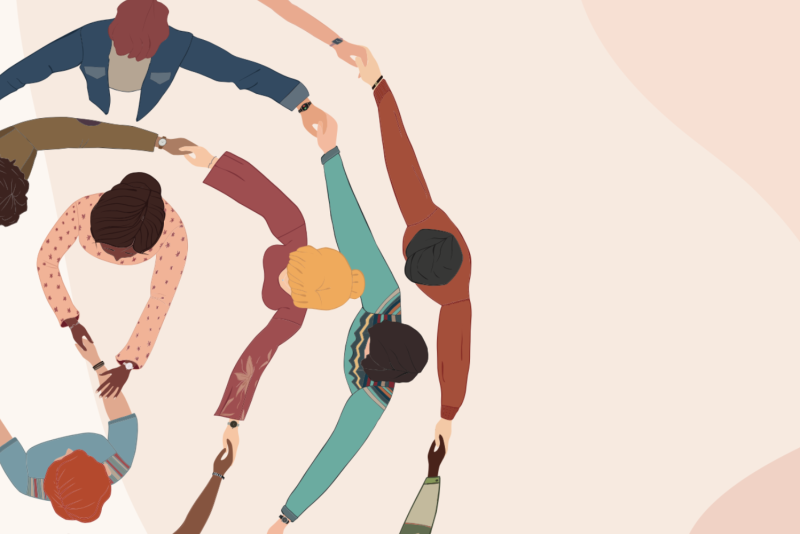The Revolving Door of Social Re-Entry and Restrictions - 13 Practical Tools for Navigating Risk, Anxiety, And Constant Change
For a moment there, in varying degrees across the world, our lives were reforming back into familiar shapes. City life, work life, social life. What started to feel like freedom, in different ways in different countries, now appears as a series of false starts.
Those of us who found stepping out into the world challenging were still trying to assess where we fall on the risk scale and whether or not we're swinging to either extreme of recklessness or paranoia. Clearly, the subjective middle path of healthy caution and suitable levels of social re-engagement looks different for everyone.
If you’re exhausted, more anxious than usual, or notice that your emotions are more intense and closer to the surface, you’re normal. You’re not failing, you’re not lazy, and you’re not bad.
What you are is a human with a functioning nervous system that’s expending too much psychological and emotional energy over an extended period of time. For many of us, with little or short-lived reprieve. In a sense, and depending on your personal experience of all of this, your reptilian brain thinks you’ve been running away from a lion for almost two years.
What’s required now is the slow and gentle rebuilding of trust in ourselves (can I peacefully handle a busy train ride?), in others (there’s a new variant, are you being cautious?), and in the world (is it safe to engage and make big plans again?).
What comes first: Risk or trust?
As psychologist Esther Perel frames it: “Risk is about tolerating the unknown. But, if we don’t take the risk, we will never know. It’s really interesting. It’s a “both, and” because the question is: “Do we need to feel trusting to take risks, or is it the act of risk-taking that allows us to develop trust?”.
We’re going from the new familiar to the unknown and back again. At a meta-systemic level, we’re met with large question marks when we dare contemplate big themes like “how does global society move forward from here?”, “when will the next pandemic hit?”, “how do I make meaning in a world changing at an exponential rate?”.
At a personal level, beneath the “do I take extra precautions against the latest variant or not?” stress, we’ve all gained new and very real insights that refuse to be hidden. People are facing and actioning huge shifts in their careers, relationships, and purpose-of-my-life fronts.
Our journeys may be unique, but we’re all faced with having to keep moving forward one baby step at a time: left foot risk, right foot trust, all the way into the unknown future.
Know this: whatever you’re feeling is okay. It’s been tough and we could all do with some self-acknowledgement and extra support. Below is your trove of easy, practical tools to help support your nervous system and mental health as you acclimate to the re-entry/restriction revolving door of current life, however that looks for you right now.
Practical Tools For Self Support
Self regulating your nervous system
When you’re feeling anxious your nervous system becomes hyper-aroused because your reptilian brain is registering a threat. Even if you’re just thinking about that upcoming social engagement, your brain tells your body to prepare to run from danger.
Below are practical, try-it-now options for down-regulating your nervous system by activating your vagus nerve, responsible for relax-rest-digest.
Meditation
Countless research studies have proven the transformative effects of meditation for people struggling with stress, PTSD, anxiety, and trauma, to name a few.
With the iRest protocol, the benefit is twofold. 1. A yoga nidra meditation can provide relief during and after practice, and 2. You gain tools which gradually build your resilience and inner resource. Meaning, you expand your ability to cope under stress, and navigate and regulate intense and uncomfortable emotions.
Lean on our comprehensive library of free meditations. There’s something for everyone.
We recommend these as a powerful starter-kit:
- 5-Minute Rest and Refresh
- Micro-Practices for Anxiety
- Rest and Digest
- Yoga Nidra for Self Nourishment
Vagal Breathing
There are two breathing hacks for stimulating the vagus nerve and cultivating calm: breath retention and lengthening your exhale.
Exercise: Inhale for a count of four, hold for four, exhale for eight, hold for four. Repeat for five minutes.
You can also follow along with this centering and energizing guided breathwork practice.
Vagal Massage
Two minutes of stimulating the nerve via points in your ears. This is best understood through a video.
Exercise: Learn how and follow along here.
Self-Massage
Loving touch is a basic human need. Self-massage is nourishing, calming, and grounding.
Exercise: Put a timer on for 10 minutes and grab some body cream. Slowly massage each hand, taking time to do so with focused attention. Include each finger, joint, and tendon. Alternate between noticing the sensations in the hand being massaged and the hand doing the massaging.
A foot massage is also an effective option.
Click here for more vagal nerve resources.
Shaking and Tremoring
When you see a dog trembling after a thunderstorm, it’s tempting to try to soothe it to get it to stop. The wiser choice is to copy it. Shaking the body stimulates the parasympathetic nervous system. It releases excess energy built up by stress and returns the body to a balanced state.
Exercise: Stand outside, barefoot if possible. Bend your knees gently and start to pulse lightly by pushing off the ground without lifting your feet. Allowing the movement to move up your entire body. Breathe mindfully as you shake. It helps to not take yourself too seriously while doing this.
Click here to learn about the scientific TRE tremoring technique as a way to release stress, trauma, and anxiety.
Going into Nature
Doctors are prescribing forest bathing as a way to get people who are feeling stressed, depressed, or anxious to go outside and commune with the natural world. Nature improves our physical, mental, and emotional wellbeing.
Exercise: A city park is not the same as an old growth forest. Make time to go to one of your favorite wild nature spots and spend a few hours walking, noticing, and absorbing some vitamin D.
Co-Regulating Your Nervous System
If you’re struggling with anxiety or other difficult emotions to the degree that they’re triggering past trauma or it’s feeling debilitating, self-regulating can be difficult if you’re not already well-versed. This is where co-regulation comes in.
Co-regulating involves asking someone you trust to help you. It’s one nervous system soothing another. “As you co-regulate with someone, the mirror neurons in their brain are activated, and this enables the person in the deregulated state to literally ‘mirror’ your calmness.” —Caroline Leaf, PhD
Co-Meditation Dyads
This is a form of one-on-one meditation and self-inquiry during which you’re facilitated and supported by someone as you explore what’s happening in your inner world. In iRest, co-meditation would be done as a private session with a teacher.
At home, you can ask someone you trust to be able to stay present to be your witness and gently ask what’s happening for you as you sit and feel sensation in your body without changing it.
[Note: iRest teachers can brush up on their Co-Meditation Dyad skills for free by logging in and watching this free class.]
Alternatively, anyone can do the co-breathing below. No experience required.
Breathing Together
This exercise is courtesy of Dr. Nicole La Pera. Watch her 20-second clip.
Exercise: Sit across from your friend, partner, or family member, and place your hand on each other’s hearts. Close your eyes and take a deep belly breath. You’ll feel each other’s hearts rising which will allow you to sync your breathing. Visualize your nervous systems both calming each other. Exhale slowly at the same time. Repeat 3-5 times.
Eye Gazing
There are many reasons to practice eye gazing, the two we’re interested in here are 1. Building confidence looking people in the eye in person again, and 2. As a tool for building trust and increasing connection.
Exercise: Start small. Set a timer for one minute. Sit opposite your partner/friend and softly gaze into each other’s eyes, blinking as you need to but not looking away.
If you don’t have someone to practice with like this, use a mirror for self-practice or challenge yourself to gently meet the eyes of the clerk at the grocery store or each person you pass on your walk.
Shifting Your Mindset
It’s easy to get stuck in negative perspectives if we’re spending a lot of time alone and in our heads. Rebuilding confidence in your ability to engage risk is an inside job. The more you trust yourself the more you can tolerate uncertainty.
Nurture Self-Trust
Exercise: Contemplate some of the biggest risks you’ve ever taken in your life. Journal about what they were and acknowledge how and why you were brave in each of these circumstances.
Reminding ourselves of the facts about previous times when we chose risk reframes our current relationship with risk by revealing our capacity for it. Showing yourself you’ve done it before proves that you can do it again.
Prepare Yourself with a Confidence Boosting or Anxiety Relieving Meditation
In the same way you prepare your body and your belongings before leaving the house, make time to prepare your mind.
Exercise: Choose a theme that resonates and take a guided meditation to resource yourself before you run that big meeting or step out into the world for the day.
You could try Relieving Stress with The Power of Attention or Meeting Your Emotions.
Re-Engage Your Sense of Humor
Pandemics are not funny. What can be taken lightly is our fumbly re-entry into the outside world. On the days you feel more newborn fawn than mature steed, give yourself a break. Have a giggle at your new inability to not be a little weird in a restaurant, or how you’ve perfected opening public doors with your elbows.
If there’s one thing we’ve all learned, it’s to care less about things that don’t really matter, and preserve our energy for what does. By now we’ve earned the wisdom needed to know the difference
Where To From Here?
In short, we’re all being asked to alter and transform our relationship with control. You can’t control reality but you can accept it while controlling how you choose to respond to it.
Decision fatigue sounds like: Do we give in to social pressure and/or ignore calls to restrict contact again? Do we trust our discernment over our peers with different perspectives and needs? Can we make room for the discomfort of dissonant decisions among our peers and family?
When lockdown laws were first issued we cohesively accepted the mandate to shrink our lives in order to minimize risk. Now, as we re-enter society in various ways, the silent ask is to increase our tolerance for uncertainty and take small risks often.
There is no one right way to live through a pandemic. Befriend yourself by accepting that 75% may be your best for now. Make time to do the practices that soothe and replenish you.
Trust yourself and accept your own timing by upholding your boundaries. Some of us have been freely out and about for months, others are still feeling hyper-cautious. Do what feels supportive for you, while not risking others’ safety.
Lean on your resources. Now more than ever we all need to take more time to engage in the practices that ground us within ourselves, making us feel connected, loved, and nurtured.
Note: If you’d like to nourish and resource yourself with practical, research-backed iRest tools during this time of prolonged stress and challenges, you can find all our live online event options here.






Join the conversation
We would love to hear what you have to say. Log in or Register to post comments.